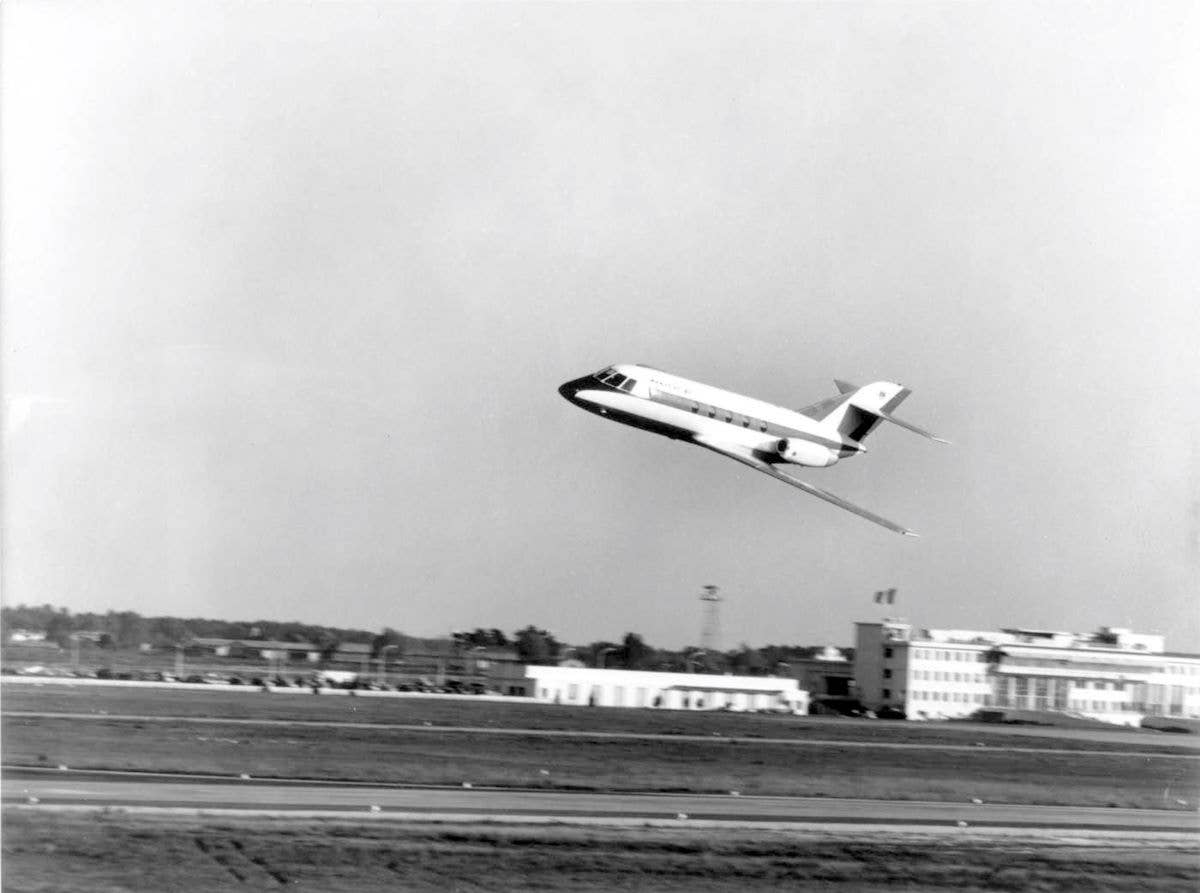The First Falcon’s First Flight
The Dassault Mystère 20 launched the era of the purpose-built business jet 60 years ago today.

The first flight of the first business jet that would become the Falcon 20 took place in Bordeaux, France, on May 4, 1963. [Courtesy of Dassault Aviation]
Marcel Dassault may have said it first—but he echoed the minds of many pioneering aircraft designers before him when he quipped, “For an aircraft to fly well, it must be beautiful.” That can certainly be said of the very first of the Falcon jets for which his company, Dassault Aviation, would become famous.
The Dassault Mystère 20 launched the era of the purpose-built business jet 60 years ago, on May 4, 1963, in Mérignac, France, beginning the Falcon jet line that would take the U.S. market by storm.
“The formula has not changed,” said Dassault Aviation’s chairman and CEO Éric Trappier. “Every Dassault aircraft must have superb handling, beautiful lines, and rugged construction. And, of course, it has to provide state-of-the-art comfort.”
Lindbergh’s Endorsement
Dassault celebrates 60 years since the Mystère 20’s first flight throughout 2023—and looks back to the events that surrounded that iconic airplane’s development and success with customers. It was a drop-in visit from Charles Lindbergh that may have sealed the Mystère’s fate. Lindbergh met with Dassault in Bordeaux on behalf of Pan Am, which was looking at the new jet as a cornerstone for its blooming business aviation division.
As history has recorded it, Lindbergh wired Juan Trippe, then CEO of Pan Am, and gave his nod to the Mystère 20: “I’ve found our bird.” Though his visit pushed the first flight from the morning hours to late in the day—at 5 p.m. local time—fortune smiled upon that inaugural mission, flown by test pilots René Bigand and Jean Dillaire.
Based on the Mirage
The Mystère 20 set the stage for Falcon jets to come with its foundation in Dassault’s strong heritage as a developer of fighters. The company had already gained a serious reputation for its Mirage line, first developed following World War II with the advent of viable turbine engines.
Dassault had responded to a request from the French government for a light-weight interceptor aircraft, and designed the MD.550 Delta, which first flew on June 25, 1952. The fighter—renamed the Mirage I—achieved Mach 1.3 in level flight a couple of years later, without rocket assistance. In early test flights, beginning in 1951, its predecessor, the MD.452 Mystére I, proved out the 30-degree swept wing and modified empennage, and the Mystère IIA was the first French aircraft to break Mach 1 in a dive in controlled flight on October 28, 1951.
While not quite as fast, the Mystère 20 would seek out speed just like its older sibling. The prototype, powered by General Electric CF700 turbofans, was flown by French pilot Jacqueline Auriol to set the women’s world speed record at the time, on June 10, 1965, beating her previous record in the Mystère IIIC of 2,038 km/h (1,100 knots) or Mach 1.65.
Onto the Falcon
Pan Am ordered 40 of the new business jet, and those aircraft delivered to the U.S. were marketed under the name “Fan Jet Falcon.” The model soon took on the name it would carry forward, the Falcon 20. By 1968, Pan Am had 160 units ordered, becoming the biggest operator. However, it was soon followed by the growing Federal Express, which took on a total of 33 Falcon 20s as it launched its overnight delivery service fleet—before the Boeing 727 and McDonnell Douglas DC-10.
The Falcon 20 deliveries totaled 515 before it was retired in 1993—a 30-year production that formed the basis for several more models in the Falcon family. Next was the smaller Falcon 10 (first produced in 1971, with 226 units delivered) and the larger tri-jet Falcon 50 (launched in 1976, with 352 units delivered).
The Falcons series took a turn into twin jets with the Falcon 900 models first produced in 1984—more than 553 900s have been delivered—and the Falcon 2000 models launched in 1993, with 677 aircraft so far. Dassault returned to the tri-jet configuration for its long-range 7X (first flown in 2005 by Philippe Deleume, with 298 units so far) and the 8X in 2015 (92 units delivered to date). These four lines remain in production, now joined by the twin-jet 6X and 10X.
From the 2,700 Falcons built, more than 2,100 Falcons fly around the world today.
“Through these different models, we have built up a strong legacy and a solid base of technological know-how that makes us confident in our ability to continue developing new products that fully meet customer expectations,” said Trappier on the occasion. “Sixty years on, Falcons are still completely distinctive in the business jet world: beautiful, delightful to fly, and always on the leading edge of technology, bringing safety, comfort and productivity benefits to operators around the globe.”

Sign-up for newsletters & special offers!
Get the latest FLYING stories & special offers delivered directly to your inbox






